“The point was that we have the potential to expand internally, like a crystallizing prism, when we grow emotionally, actualizing greater beauty, maturity, and complexity as human beings. This happens by engaging consciously, and on purpose, in emotional work that connects to the spiritual.” ~ Leila Currah (excerpt from this post)
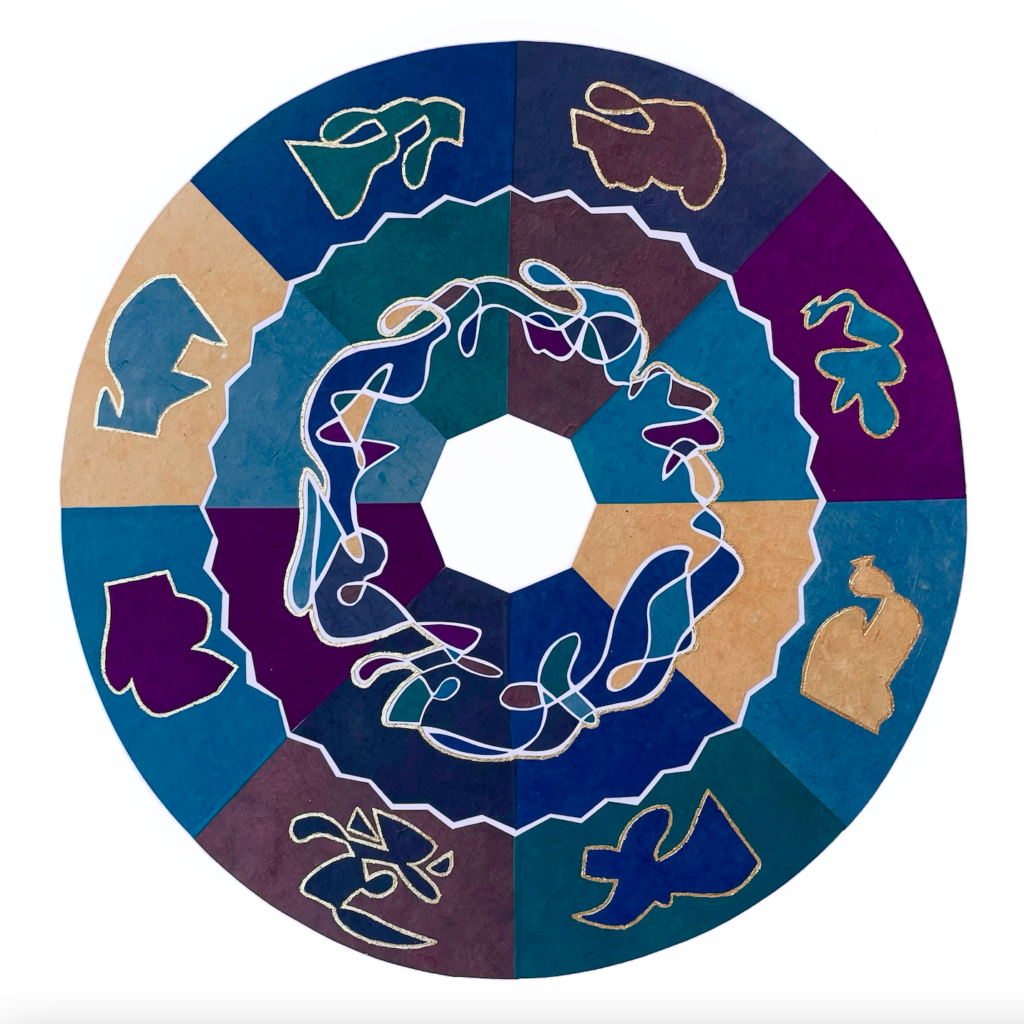
This cutout was the creative result of a Blessings workshop over Zoom with IDHHB. The workshop was a doubly special event because we were also celebrating the 79th birthday of my teacher, E.J. Gold.
E.J. has been my spiritual teacher for nearly two decades, a constant support, and an inspiration to me creatively. My connection with him, though varied, has always centered around the practice of making art for spiritual transformation. The synergistic experience of creating this mandala came from a singular insight he shared during the workshop that spoke to me.
Here’s how it all happened.
During the workshop, we were on the topic of emotion. In typical dharmic exposition, familiar to those of us peculiar creatures still alive who have spent time around teachers who are products of the 1960’s human potential movement, E.J. suggested that the octagon of emotion within normal human range could be expanded into a triacontradigon of higher emotion. It was either divine revelatory insight descending then and there from the heavens or perhaps just a passing thought. A nice image, I thought. A polygon expanding to greater size and additional complexity. A triacontradigon is a 32-sided shape.
My vision was simple: to produce a mandala based on those shapes.
The whole creative process of making the mandala took 10 days from start to finish.
When I think of the normal human range of emotion, I think of emotions such as joy, worry, anger, sadness, satisfaction, pride, anxiety, distress, grief. I had recently been exploring emotion in comic form during one of my 22 Day Art Challenges on Instagram. (More on that later.) Emotion was fresh on my plate. I certainly don’t think the point was that we would do well to compile a list, somehow arrive at 32, and call it a day. No, not at all that. Besides which, there are certainly more than eight regular emotions. The point was that we have the potential to expand internally, like a crystallizing prism, when we grow emotionally, actualizing greater beauty, maturity, and complexity as human beings. This happens by engaging consciously, and on purpose, in emotional work that connects to the spiritual.
I do believe that all of our worldly emotions are natural and necessary, when managed, and that it’s important to feel whatever may arise in the normal range. Management is vital, though, lest we be led by aggression.
I ended up in conversation with a friend of mine the following day after the workshop. She is a Christian and we just happened to get into a conversation about emotion, during which she contrasted worldly sorrow with divine sorrow. Both are real, she reflected. There’s nothing to suppress in world sorrow. It’s part of life. Yet, divine sorrow helps direct us towards redemptive possibility and transformation. I love the way she described this. It seems to me that the gradations of emotion that serve to transform us are subtle and sometimes hard to name beyond an All Encompassing Love. However, having gone through the process of making the mandala, further insight emerged.
At this point, I think I should describe the art.
I started with an illustration board, lightly sketching an octagon, then drew the 32-sided shape around it, measuring carefully, using a ruler and a protractor. The notches in the triacontradigon were created by drawing a line to connect every 6th dot. I figured it would make the shape more recognizable that way, since it’s practically a circle when the dots are connected directly. Then, using tracing paper, I created a pattern that I could, in turn, use to cut out eight solid pieces of paper, sandwiched between my polygons. This was the result.
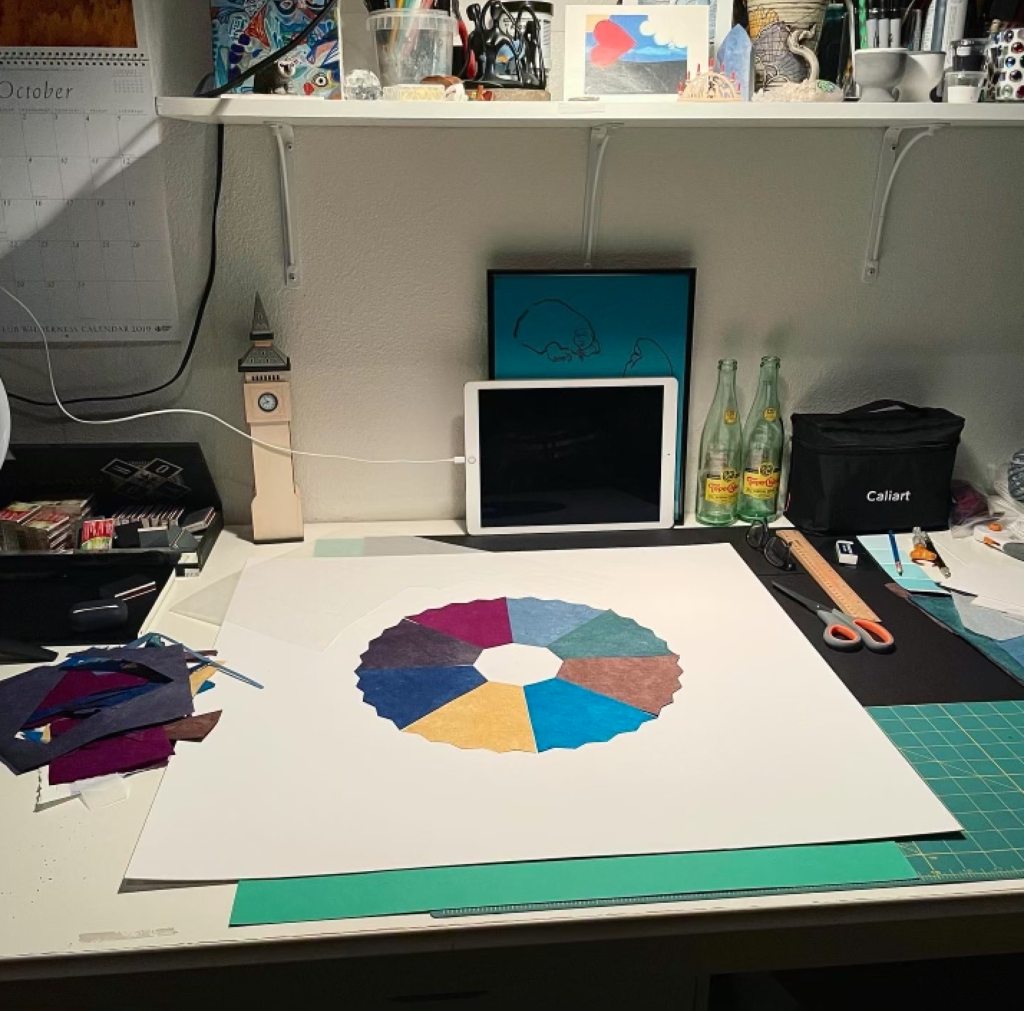
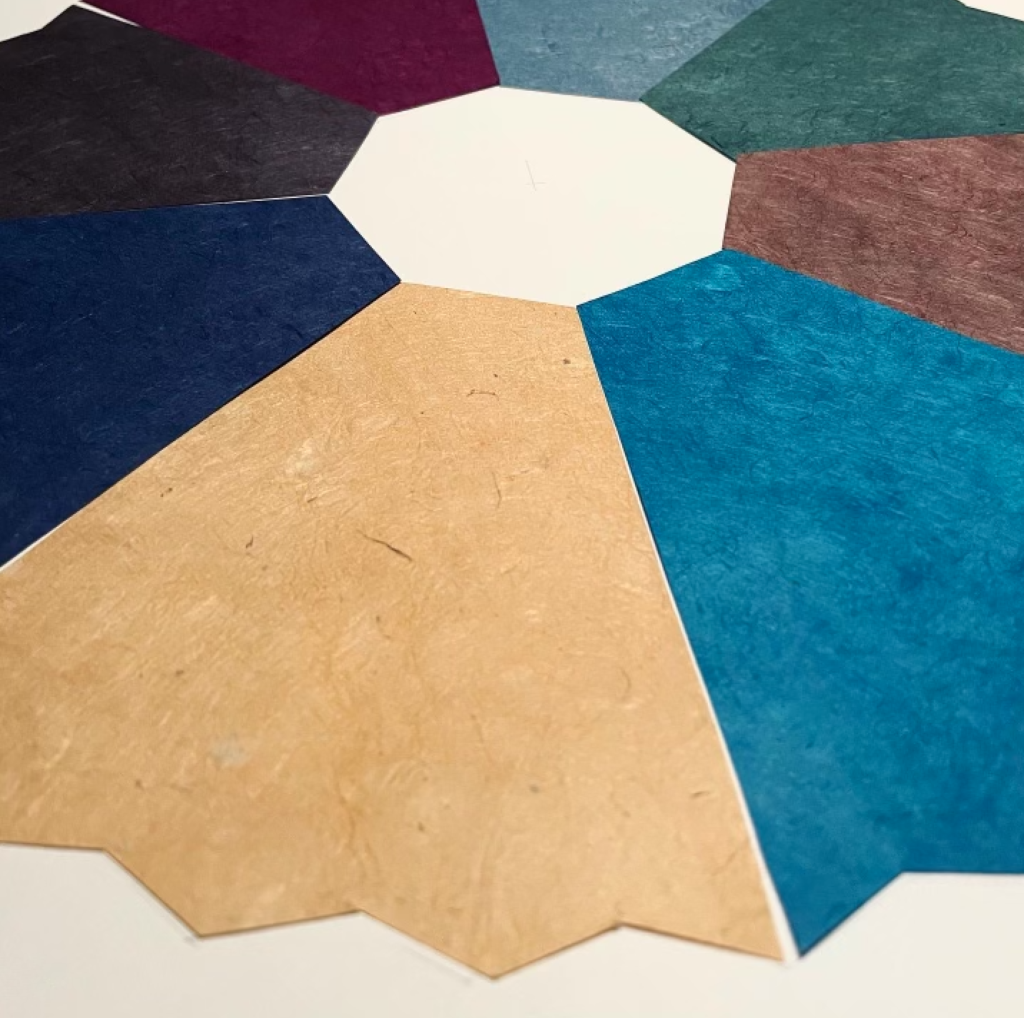
From there, I lay more tracing paper on top and sketched a curving double-lined pattern, which is one of the signature designs of our group of artists. This established a clear connection to our community. I did this very much on purpose. There was one little jumble that required repair which you can see in the photos. I simply cut out the jumble, lay down more tracing paper and made sure that the new lines started off in the right direction and ended in the right direction.
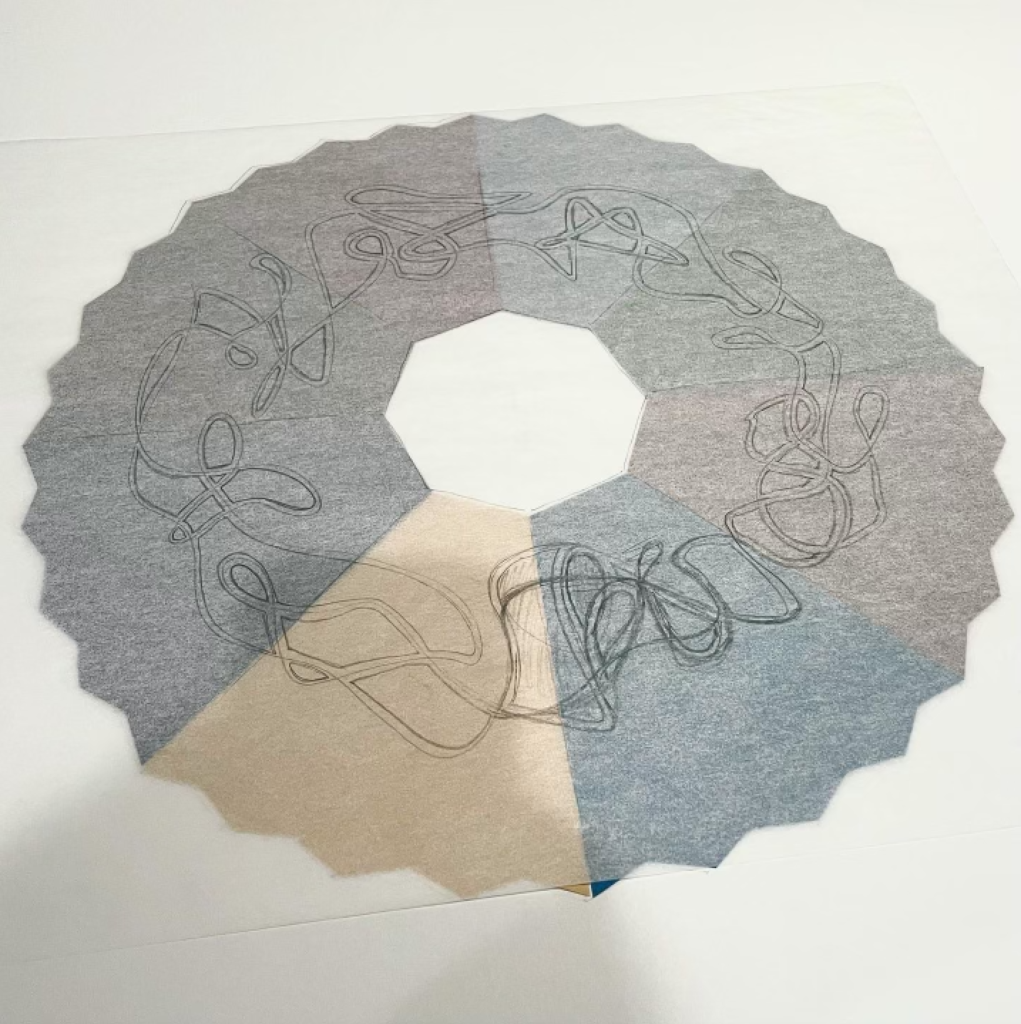
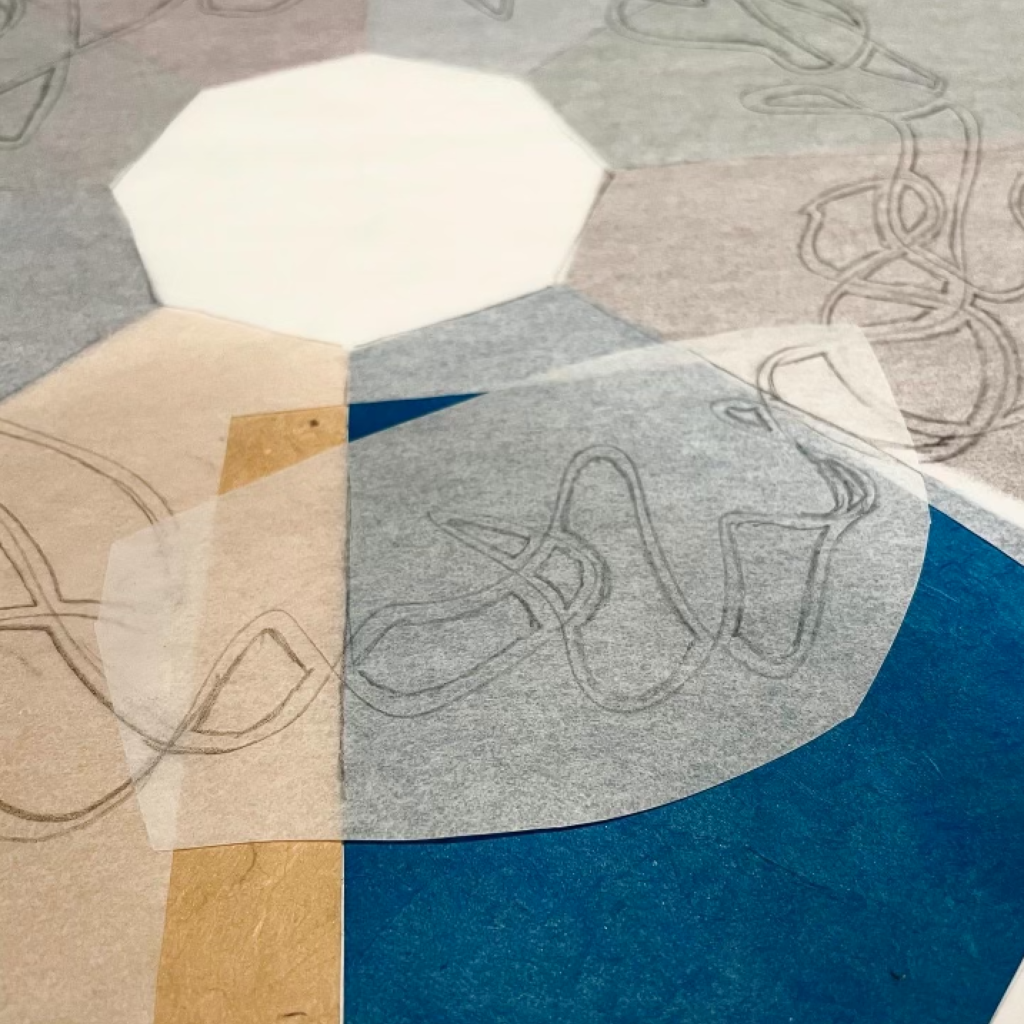
Then, I cut out those sections as solid pieces, which I would save for later.
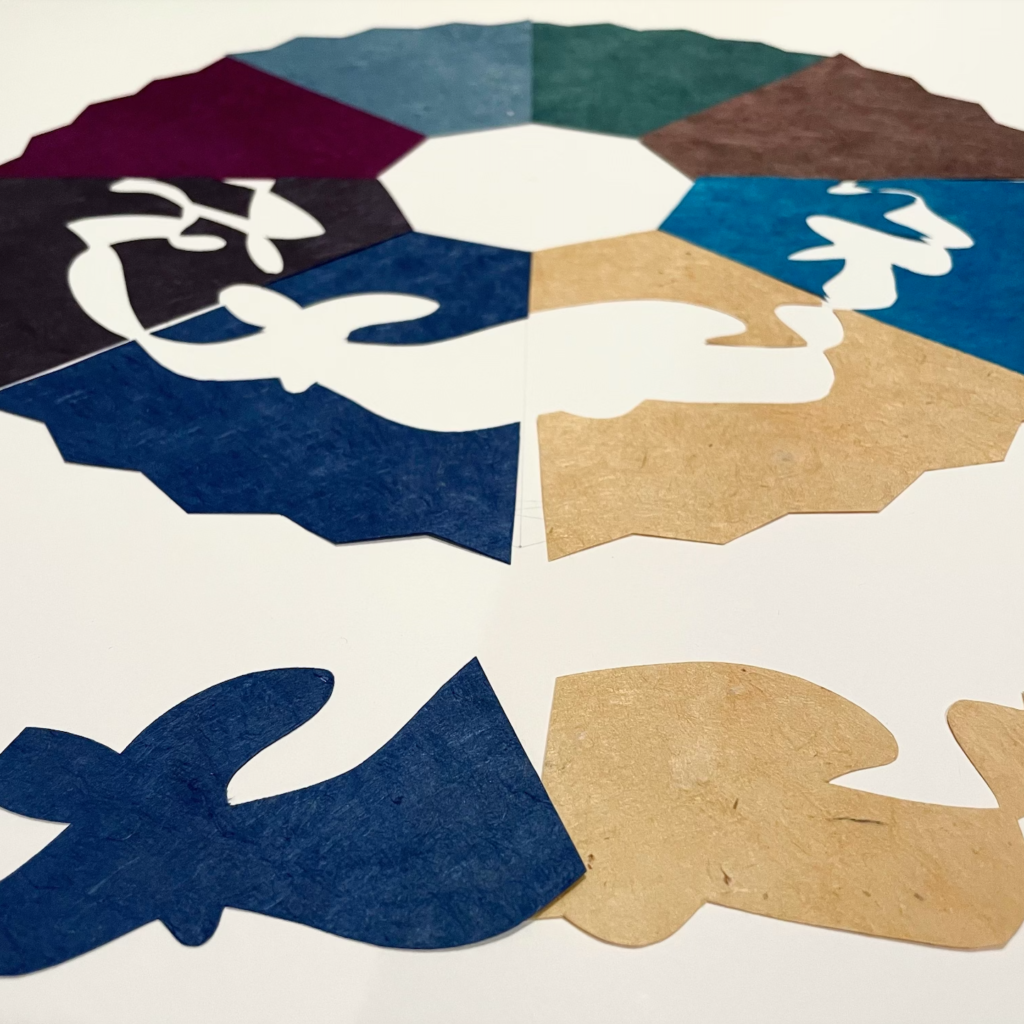
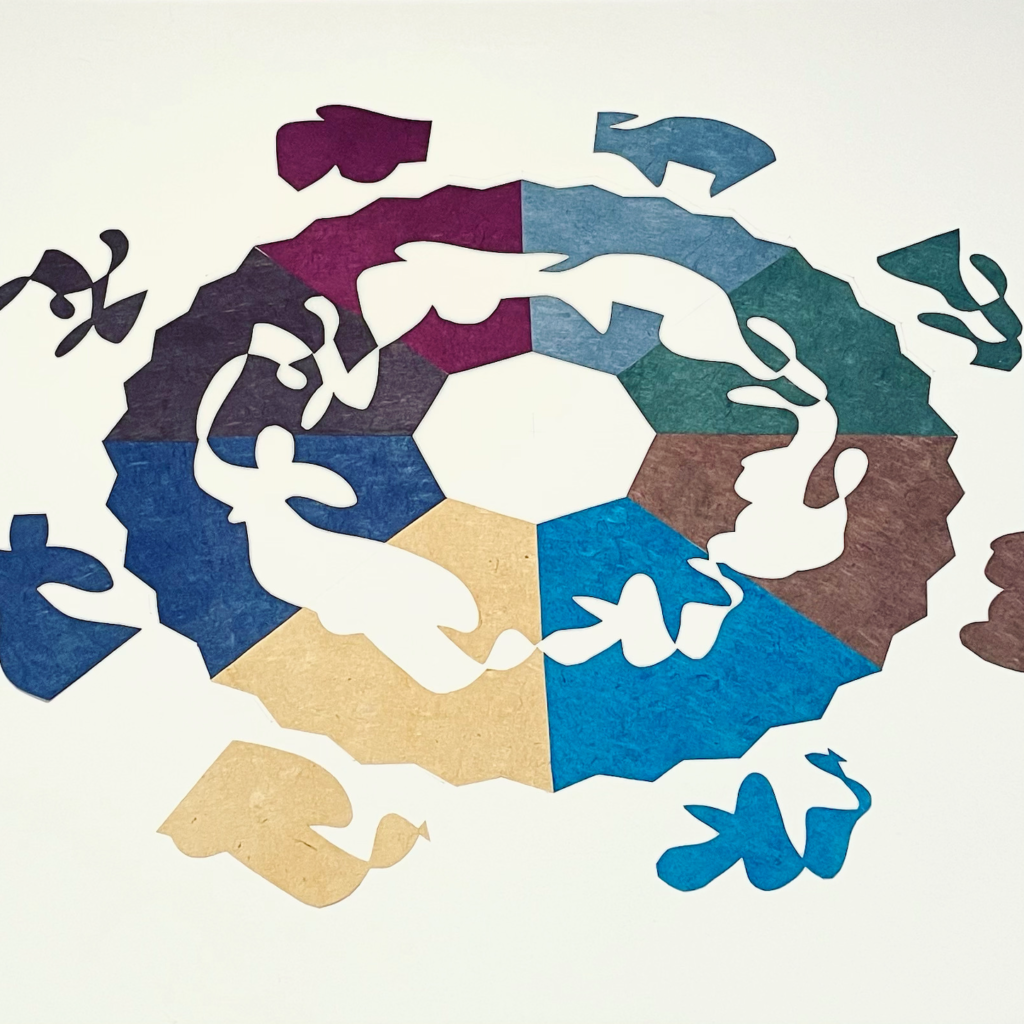
The echo between the cut-out solid pieces and the inner design is perhaps most evident in the photo above. At this point in the arrangement, I saw these hovering solid pieces as angelic forms. Eventually, they would take on other meaning.
I proceeded to recreate the inner pattern using smaller individual pieces in different colors. There was a rhyme and reason for which colors went where, but I’ll leave it to you to see if you can figure out the rules I was following.
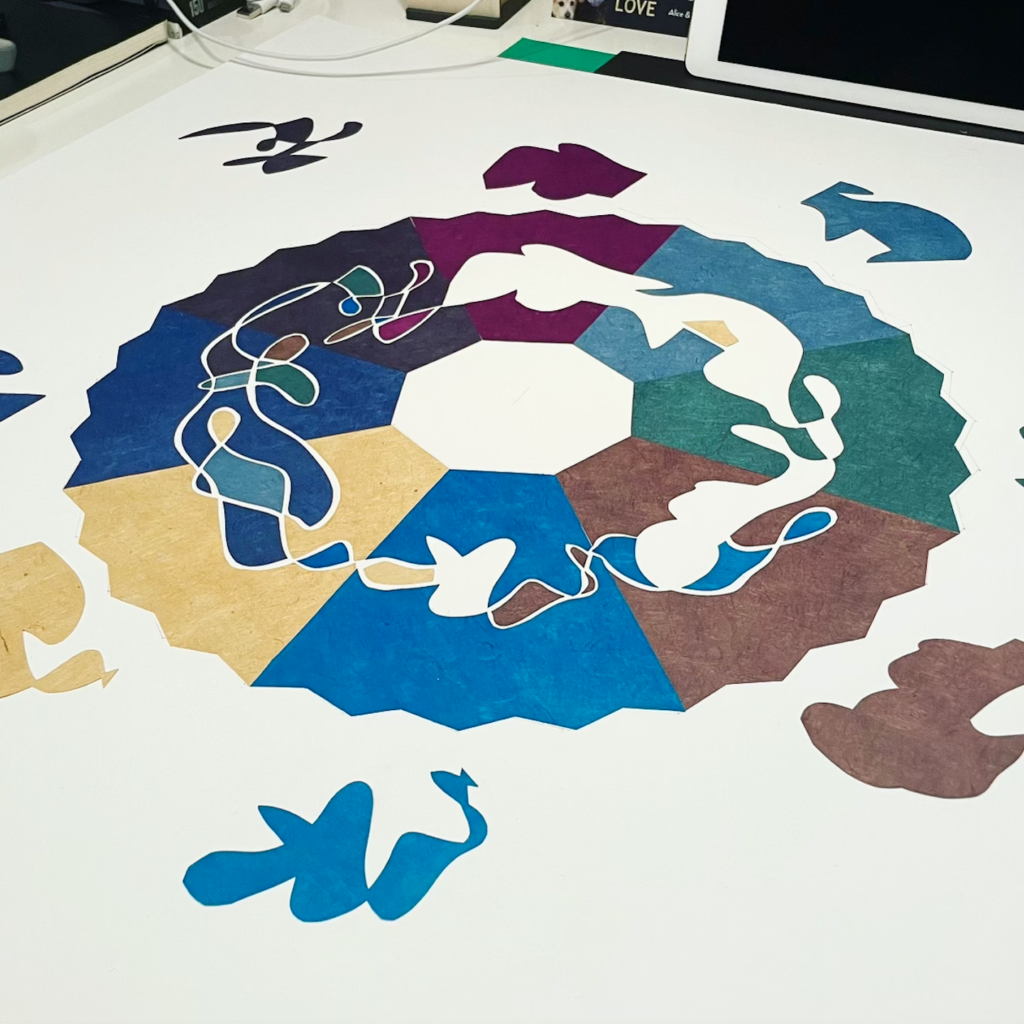
Here you can see the process whereby the smaller pieces were added, one at a time, ever so carefully. When I’m engaged in a process like this, it’s best not to worry about wrecking the whole thing, although there were plenty of wrong moves that would have done the trick, i.e., dropping a piece covered in glue, or mislaying it slightly, or accidentally scratching the surface with some implement in my studio, or accidentally destroying one of the original cut-out pieces that was extracted in the previous step. That wouldn’t be the end of the world; I could always recreate one, but it would have been a magical error.
At any rate, things were going so far so good. Best to carry on when a flow is happening. Rather than allow the outer pieces to float, I decided to embed them in an outer shell.
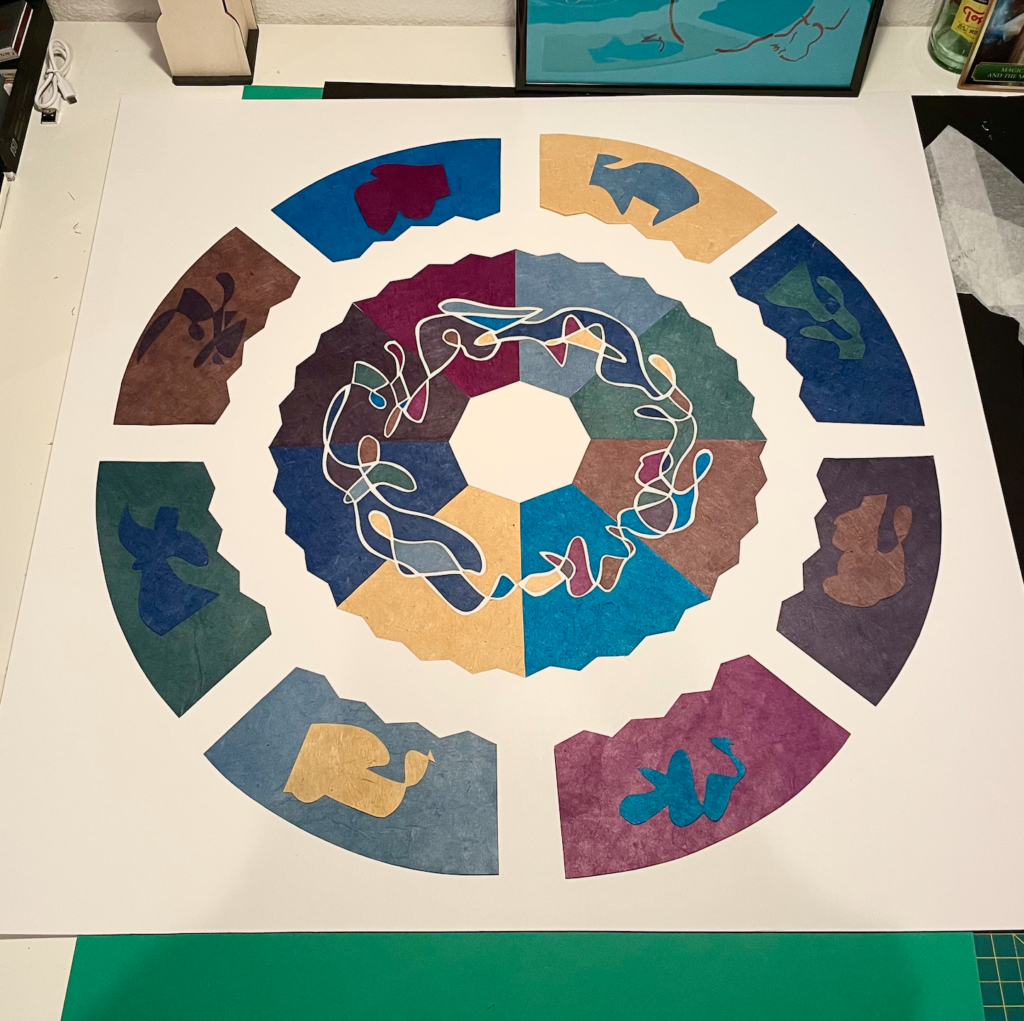
It was exactly at this point in the creative process that I discovered that, while all my art-making was going on, E.J. had just written a blog entry on Portals. When I read it, I was struck instantly by the fact that my artwork was exactly one such portal, replete with some kind of hidden locking mechanism I didn’t fully understand, but clearly eight keys laid out in plain view around the outside of the design, which, as you recall, were cut directly from the inner design. Those cut-out shapes were then laid onto outer blocks of color (as seen in the above photo) and would soon be drawn together to give the mandala a clear circular, seamed perimeter.
As I said before, the angelic forms took on a new meaning. When I read E.J.’s blog, the flip happened, and that was that. What were pure abstractions became oddly shaped keys.
I didn’t know what exactly they might further represent yet, so I carried on with the creative process.
Once connected and glued, the gold leafing began. This process involves a red base coat, which you can just make out around the keys in the photo below, followed by an adhesive, which requires a 60 minute setting period, give or take, and the careful laying down of gold leaf, without too much waste. I achieve this my cutting the gold leaf into smallish pieces. Once it’s down, I use a brush to press it into the adhesive, and then brush away the excess.
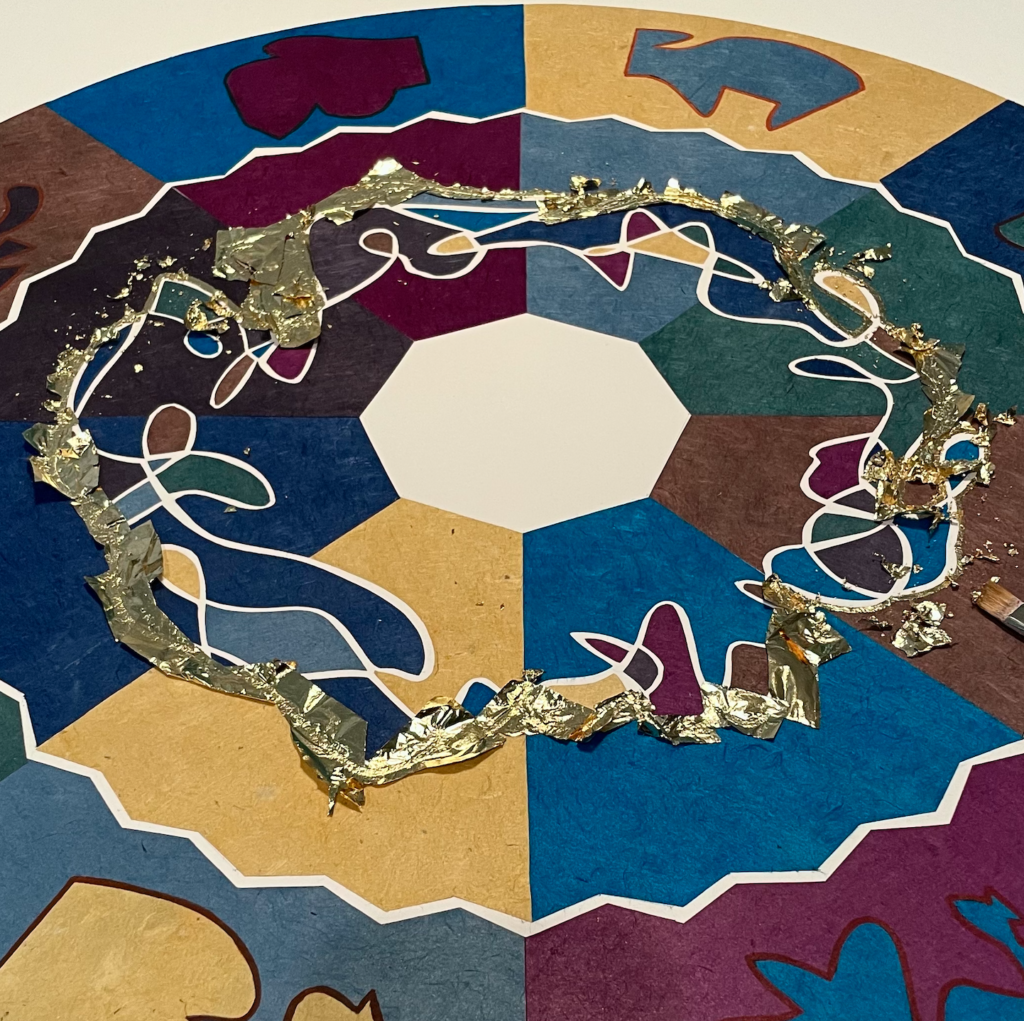
To my mind, that dance of color through the twisting lines is the realm of phenomena and the gold-leafing on the outer ribbon is the blessing of top-down creative expression from the Angelic Realm, or bottom-up, depending on how you see things.
The outer cut-out shapes of color. The keys. Remember how I said they looked like angelic forms to me? The angelic shapes had transformed into keys, and now, it was only now, that I realized that those keys might be specified. I began to sense that those 8 Keys were Special Emotions within our capacity as humans to develop.
The final step was to gold leaf each one, and meanwhile, contemplate what they each might uniquely represent, such that, when unified as a Group of 8, would generate Special Transformational Power. Which Special Emotions might enable us to develop to our fullest capacity and perform fully in the Work?
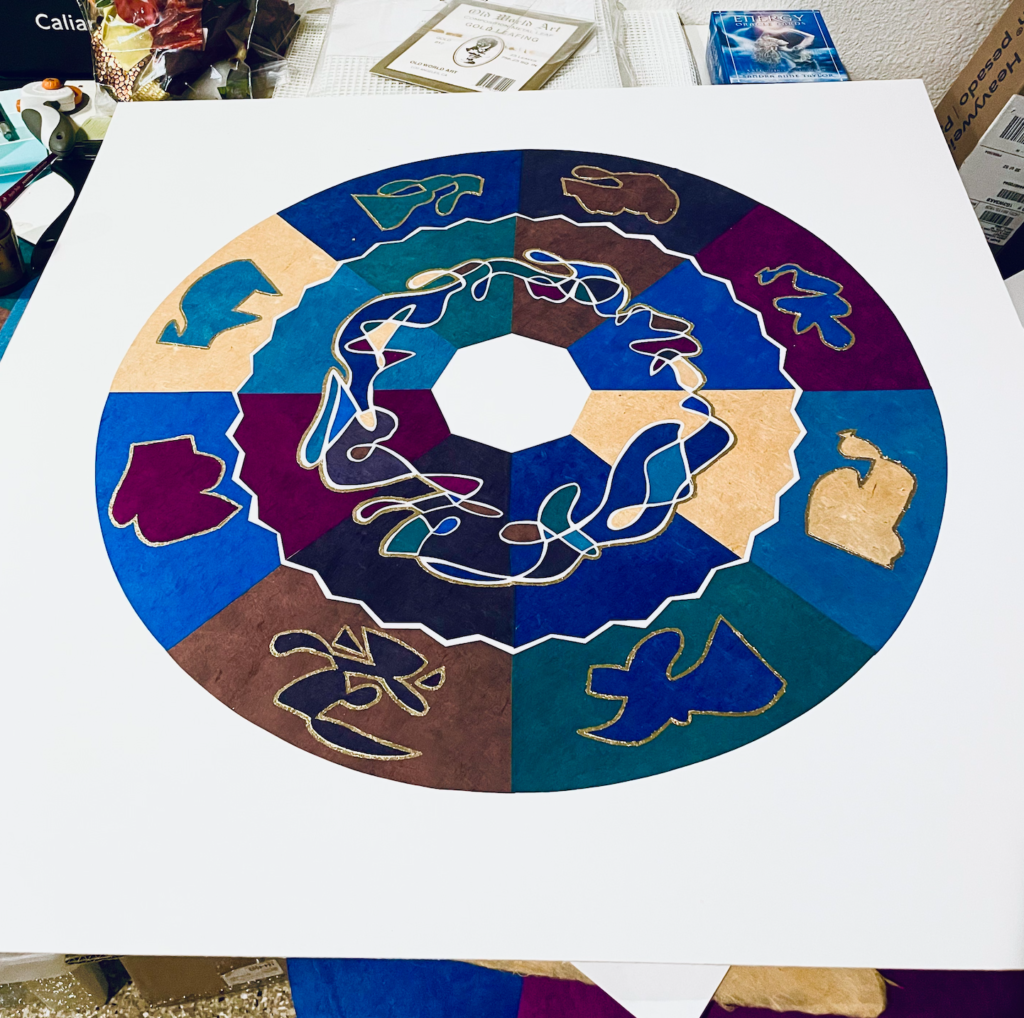
This is my conclusion and the fruit of this labor. These are the Keys I can specify from my own process of reflection:
GRATITUDE
LOVING-KINDNESS
COMPASSION
TOLERANCE
FORGIVENESS
HUMILITY
JOY
DEVOTION
I know, this is age-old wisdom. This set of principles is nothing new. However, it’s one thing to identify such principles. Practice is a whole other ballgame. After all, talking is not walking, and walking the walk is what matters on the spiritual path.
Perhaps, the idea of cultivating these heart-qualities through very specific practices, is looking for a new package.